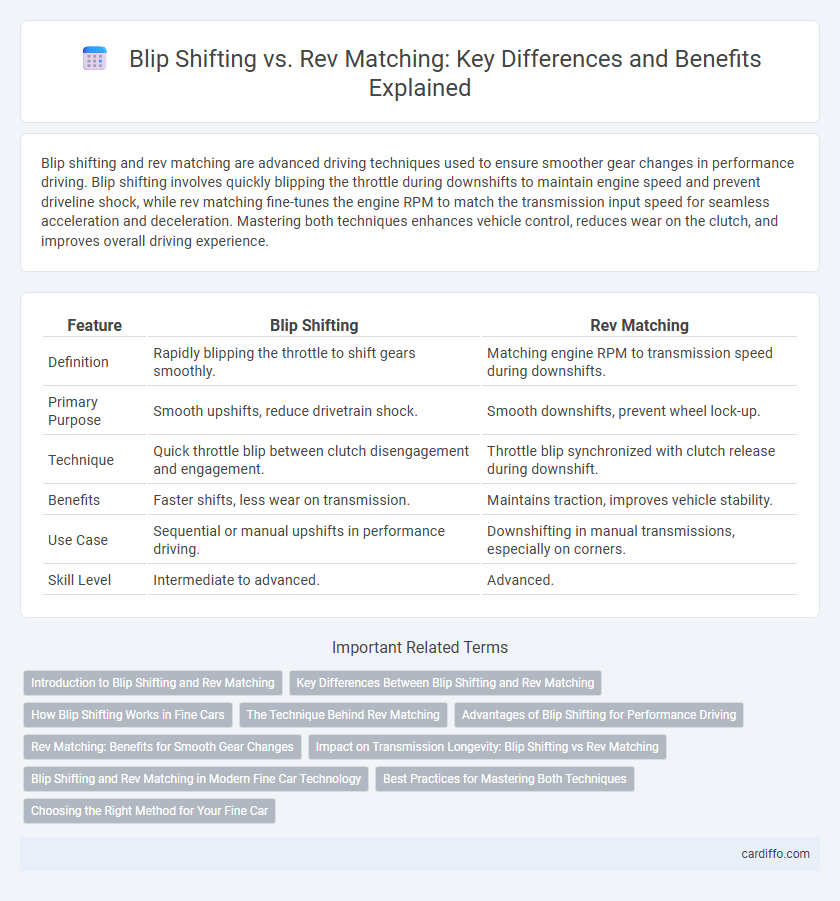Blip shifting and rev matching are advanced driving techniques used to ensure smoother gear changes in performance driving. Blip shifting involves quickly blipping the throttle during downshifts to maintain engine speed and prevent driveline shock, while rev matching fine-tunes the engine RPM to match the transmission input speed for seamless acceleration and deceleration. Mastering both techniques enhances vehicle control, reduces wear on the clutch, and improves overall driving experience.
Table of Comparison
| Feature | Blip Shifting | Rev Matching |
|---|---|---|
| Definition | Rapidly blipping the throttle to shift gears smoothly. | Matching engine RPM to transmission speed during downshifts. |
| Primary Purpose | Smooth upshifts, reduce drivetrain shock. | Smooth downshifts, prevent wheel lock-up. |
| Technique | Quick throttle blip between clutch disengagement and engagement. | Throttle blip synchronized with clutch release during downshift. |
| Benefits | Faster shifts, less wear on transmission. | Maintains traction, improves vehicle stability. |
| Use Case | Sequential or manual upshifts in performance driving. | Downshifting in manual transmissions, especially on corners. |
| Skill Level | Intermediate to advanced. | Advanced. |
Introduction to Blip Shifting and Rev Matching
Blip shifting involves momentarily increasing engine RPM by briefly opening the throttle during gear changes, helping to match engine speed to transmission speed and achieving smoother downshifts. Rev matching requires precise throttle control to align engine and wheel speeds manually, reducing drivetrain shock and improving vehicle stability during gear transitions. Both techniques enhance driving performance by minimizing jerks and maintaining momentum, with blip shifting often favored for its efficiency in fast, seamless gear changes.
Key Differences Between Blip Shifting and Rev Matching
Blip shifting involves quick throttle blips during gear shifts to maintain engine speed alignment, optimizing smooth downshifts primarily in manual transmissions. Rev matching uses precise throttle control to match engine RPM with the transmission speed, reducing drivetrain shock and enhancing vehicle stability. The key difference lies in blip shifting's quick throttle bursts for shift smoothness versus rev matching's meticulous RPM synchronization for mechanical harmony.
How Blip Shifting Works in Fine Cars
Blip shifting in fine cars involves briefly increasing engine RPM by quickly pressing the throttle while downshifting to match the engine speed with the lower gear. This technique ensures smoother transitions, reduces drivetrain shock, and enhances overall control during aggressive driving. By precisely timing the throttle blip between clutch disengagement and engagement, blip shifting minimizes wear and improves performance in high-end sports and performance vehicles.
The Technique Behind Rev Matching
Rev matching involves precisely blipping the throttle to match the engine speed with the lower gear's RPM during downshifts, ensuring seamless gear engagement and reducing drivetrain shock. This technique requires synchronizing engine speed to the transmission input shaft speed, which minimizes wear on the clutch and transmission components. Blip shifting combines clutch disengagement and throttle blipping, allowing smoother and faster downshifts, especially in performance driving scenarios.
Advantages of Blip Shifting for Performance Driving
Blip shifting offers significant advantages for performance driving by enabling faster and smoother downshifts, which helps maintain optimal engine RPM and traction during corner entry. This technique reduces drivetrain shock and preserves the car's balance, enhancing overall stability and control on the track. By executing precise throttle blips, drivers can achieve quicker lap times through seamless gear transitions without interrupting acceleration.
Rev Matching: Benefits for Smooth Gear Changes
Rev matching synchronizes engine speed with transmission input, reducing driveline shock and enhancing smoothness during downshifts. This technique improves vehicle stability and prolongs transmission life by minimizing abrupt RPM changes. Drivers experience quieter, more seamless gear transitions, especially in performance and manual driving scenarios.
Impact on Transmission Longevity: Blip Shifting vs Rev Matching
Blip shifting reduces torque shock on the transmission by precisely matching engine RPM during downshifts, minimizing wear on synchros and gears compared to abrupt downshifts. Rev matching further enhances transmission longevity by ensuring smoother clutch engagement and reducing driver-induced drivetrain shock, promoting consistent component alignment. Both techniques extend transmission lifespan, but rev matching offers superior protection during aggressive driving by maintaining optimal rotational speeds throughout gear changes.
Blip Shifting and Rev Matching in Modern Fine Car Technology
Blip shifting and rev matching are advanced techniques in modern fine car technology designed to enhance gear changes and driving smoothness. Blip shifting involves briefly increasing engine RPM by "blipping" the throttle during downshifts to match the engine speed with the lower gear, reducing drivetrain shock and maintaining vehicle balance. Rev matching, integrated into many performance cars' electronic systems, automatically adjusts engine revs during both upshifts and downshifts, improving shift precision and extending transmission life.
Best Practices for Mastering Both Techniques
Blip shifting requires precise timing and quick throttle blips to smoothly match engine RPM with downshifts, preventing drivetrain shock and maintaining vehicle balance. Rev matching involves synchronizing the engine speed with the transmission input shaft by blipping the throttle during gear changes, essential for performance driving and extended clutch life. Mastery of both techniques depends on consistent practice, understanding engine response, and developing muscle memory to execute seamless, fluid shifts in various driving conditions.
Choosing the Right Method for Your Fine Car
Blip shifting and rev matching both enhance smooth gear transitions in fine cars, but selecting the right technique depends on driving style and vehicle type. Blip shifting offers precise throttle control ideal for spirited driving and performance-focused cars, while rev matching excels in maintaining drivetrain longevity and comfort in everyday driving scenarios. Understanding your car's response and intended use ensures optimal performance and reduced mechanical wear.
Blip shifting vs Rev matching Infographic

 cardiffo.com
cardiffo.com